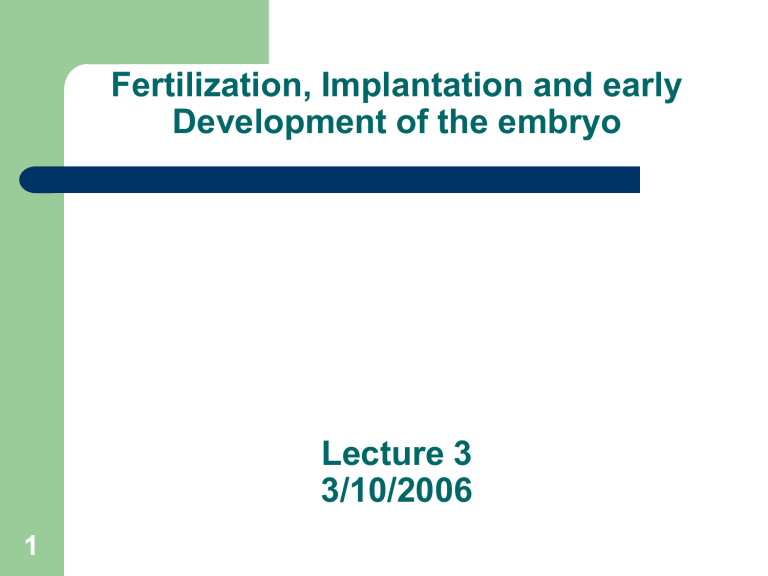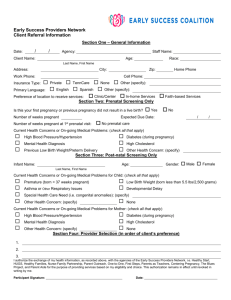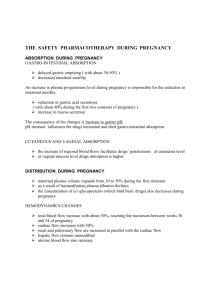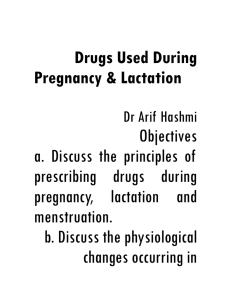Fertilization, Implantation and early Development of the embryo

1
Fertilization, Implantation and early
Development of the embryo
Lecture 3
3/10/2006
Placenta
2
Remarkable organ originating from trophoblast layer of fertilized ovum.
Placental functions
Transport
Respiratory
Nutrient function
Hormone production
Storage
Barrier function (molecular as heparin, syphilis, toxoplasma
3
Abnormalities In Placenta
– Placenta Marginata : disorder of placental attachment, mild type of abruption in which slight separation occurs at the edge of placenta in region of marginal sinus of mother.
– Placenta circumvallata : opaque ring seen on fetal surface, its formed by doubling edge.
– Placenta membranacea : covered all of the fetus.
– Placenta Accretta, increta, percreta
Fetus
4
Rate of growth development under control of genetic control and nutrient in body
Size
--5th wk- sac
--12th wk-30gm
--28th wk-1100gm
--Full term-50cm (2700-3600 gm)
Fetal Circulation
5
During intra uterine life of fetal, respiratory system is not functioning because oxygenation of blood is occurring in placenta, therefore 4-temporary structures in fetal circulation, these are
Ductus Venous : runs from umbilical vein to the vena cava, it carries oxygenated blood to the heart
Foramen Ovale : allows blood to flow from Rt atrium directly to Lf atrium (bypass Rt ventricle and fetal lungs).
Ductus Arterioses : communicating duct from pulmonary artery to descending arch of aorta, it carries deoxygenated blood.
Hypo gastric arteries : branching from internal iliac arteries to enter the umbilical cord as umbilical arteries
6
Summary of fetal circulation
7
–
–
–
–
–
–
–
–
–
–
O2 blood enters fetus via umbilical vein
Umbilical vein goes straight to liver ,however most of blood go to Ductus venous to inferior vena cava
Inferior vena cava carrying co2 blood from lower parts of fetus
Inferior vena cava empties its blood into Rt atrium
Main volume of blood passes straight to Lt atrium via foramen Ovale.
From Lf atrium blood passes to Lt ventricle and out into aorta to supply brain and upper limbs
Co2 blood returned from upper part of body via superior vena cava
From superior vena cava blood travels through Rt atrium and ventricle to enter pulmonary artery
Most of the blood bypasses through Ductus Arterioses straight to descending arch of aorta
Main volume of blood diverted through hypo gastric arteries to cord and then to placenta as umbilical arteries for replenishment.
Changes after birth
8
After clamping umbilical cord and take first deep breath as a result of stimuli like
Infant’s thorax first compressed and rapidly re expands during delivery
-Cold of external environment
-Bright lights
-Noises
Pressure on infant’s body and sensation of weight
9
Amniotic Fluid (liquor)
Allows growth and free movement of fetus
Equalizes pressure and protect fetus from injury
Maintains temperature and provides small amounts of nutrients
In labour protects placenta and umbilical cord from pressure of uterine contractions
10
Aids effacement of cervix and dilatation of uterine os.
Abnormalities
11
Polyhydraminus: exceeds 1500 ml (e.g. encephalopathy)
Oligohydraminus: less than 300 ml (e.g. fetus unable to pass urine)
Meconium: in case of fetal distress
Umbilical Cord
Length 15-120 cm (average 50cm) sufficient to allow delivery of baby without traction to placenta occur.
-Transmits umbilical blood vessels
12
-Two arteries from internal iliac artery, un oxygenated blood and one vein from Ductus venosus having oxygenated blood.
Abnormalities
13
Less than 40 cm short cord
Very long cord may wrapped around neck or body of fetus or become knotted
True knots result occlusion of blood vessels
False knots
Fetal Membranes (amniotic Sac)
14
Function
keep amniotic fluid
Asses in formation of fluid
Protection
Asses material exchange.
15
Terminology
Para - number of births after 20 weeks gestation regardless of whether the infants were born alive or dead, twins are considered a single para
Primagravida - woman pregnant for the first time
Mulrigravida - woman who is in her second or more pregnancy
Terminology
16
Gravida -any pregnancy, regardless of duration
Nulligravida - a woman who has never been pregnant
Primapara -woman who has not given birth at more than 20weeks gestation
Multipara -woman who has given birth two or more times at more than 20 weeks gestation
17
Trimesters & length of pregnancy
Average Pregnancy lasts 280 days40 weeks and is divided into trimesters
– 1 st trimester 0-
3months(13WK)
–
–
2 nd Trimester 3-6 months(26WK)
3 rd Trimester-6-9 months(39WK)
–
–
10 lunar months
9 calendar months
18
Profile of previous obstetric history
GTPALM
G =gravida
T =term
P =premature births
A =abortions
L = number of living children
M = multiple births
GTPALM
A lady who is pregnant has 3 children and a history of 1 miscarriage (abortion).
19
This would be written as follows
– G T P A l M
– 5-3-0-1-3-0
20
Other institutions use only 2 letters
– P & G to indicate PARA and Gravida
– A woman pregnant for the first time would be
P 0, G 1
A woman is pregnant has 4 children and has a history of 2 abortions
P4, G 7
21
DETERMINATION OF DATE OF
BIRTH
Nagele ’s rule
1st day LMP - 3 months + seven days
LMP Oct 10 th2003
-3mts July 10 th
+7 days
EDD= July 17 th 2004
Pre-natal care
22
Improved pre-natal care has dramatically reduced infant and maternal mortality
Detecting potential problems early leads to prompt assessment and treatment
Preventative measures such as adequate nutrition, proper exercise, assessment of pregnancy and a planned regimen of care are essential
A pregnant woman should seek health care as soon as she suspects she is pregnant
23
The initial pre-natal visit
The initial visit will include the following data collection
– Health history
– Past medical history
– Genetic disorders
– Obstetric history
– Personal & social history
– Physical assessment
Take health history
last period started on
menstrual cycles are regular and how long they usually last;
details about any gynecological problems
details about any previous pregnancies.
medical history, including chronic conditions and medications used to treat them, drug allergies, psychiatric problems, and any past surgeries or hospitalizations
24
ask about activities such as smoking, drinking, and drug use that could affect pregnancy.
25
Take family health history
ask if any of relatives or baby's father or his relatives have had any chronic or serious diseases
Do a genetic and birth defect history
ask if you, the baby's father, or anyone else in the family has a chromosomal or genetic disorder or was born with a structural birth defect.
know about all the medications and nutritional supplements you've taken since your last period
26
any exposures to potential toxins
27
Pre-natal visits
At each pre-natal visit the nurse collects the following data
– Weight
– Urine for glucose & protein
– Vital signs
–
–
Doppler of the fetal heart beat
Leopold ’s maneuvers to determine presentation of the fetus
– Assessment of fundal height
Signs of pregnancy
(table9.2),P.223
– Presumptive signs -these signs suggest pregnancy
– Probable signs -indicate that the woman is most likely pregnant
28
– Positive signs definite evidence that a woman is pregnant
29
30
31
Signs of pregnancy
32
Presumptive
Amenorrhea
Nausea & vomiting
Urinary frequency
Quickening
Uterine enlargement
Pigmentation changes
Probable
Goodell’s
Hegar’s
Chadwick's sign, ballottement braxton hicks contractions
+preg test
Positive
Fetal heart sounds,
Outline & move on ultrasound
How do pregnancy tests work?
33
All pregnancy tests look for a special hormone in the urine or blood that is only present when a woman is pregnant. This hormone, human chorionic gonadotropin
(hCG), is also called the pregnancy hormone.
What's the difference between a urine and a blood pregnancy test?
34
Blood tests can pick up hCG earlier in a pregnancy than urine tests can.
-Blood tests can tell if you are pregnant about 6 to
8 days after you ovulate (or release an egg from an ovary ).
-Urine tests can determine pregnancy about 2 weeks after ovulation. Some more sensitive urine tests can tell if you are pregnant as one day after you miss a menstrual period.
35
Counsel and let woman know what's coming
eat well
weight gain
Discomfort of early pregnancy
symptoms that require immediate attention
Nursing Diagnosis
Health-seeking behaviors related to interest in maintaining optimal health during pregnancy
Anxiety related to minor symptoms of pregnancy
Risk for fluid volume deficient related to nausea and vomiting
36
Constipation related to reduced peristalsis during pregnancy
Nursing Diagnosis-Cont.
37
Disturbed body image R/T change of appearance with pregnancy
Risk for ineffective sexuality patterns
R/t fear of harming fetus during pregnancy.
Disturbed sleep pattern R/t frequent need to empty bladder during night
Fatigue R/t metabolic changes of pregnancy.
Danger signs during pregnancy
Headache –visual disturbances, or dizziness
Increase in systolic BP 30mmHg or more
Increase in diastolic blood pressure 15mmHg
Epigastric pain
Burning on urination or backache
Abnormal fatigue and nervousness
Anginal pain, shortness of breath
Muscular irritability, confusion, seizures
38
Vaginal bleeding or fluid leaking from the vagina






